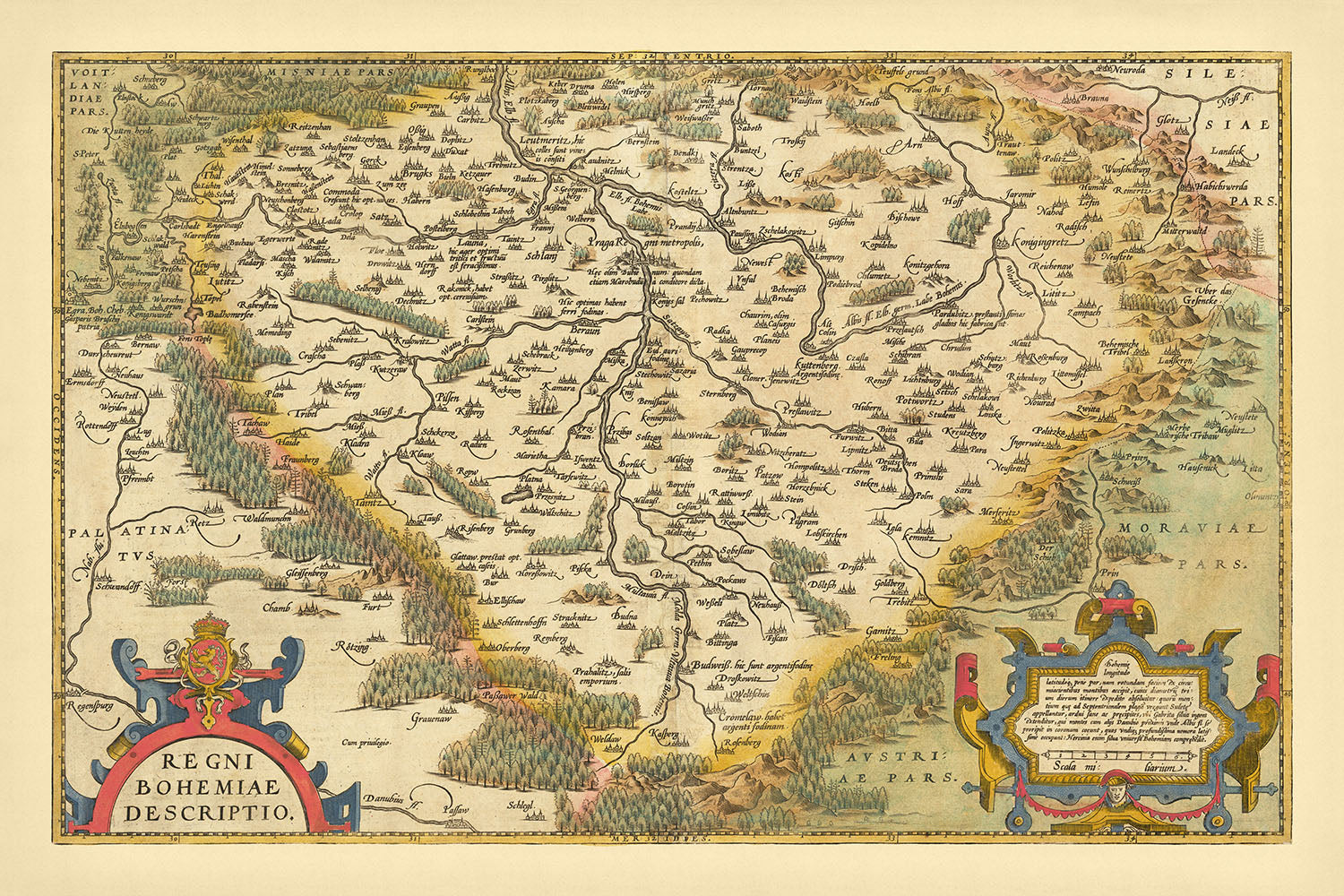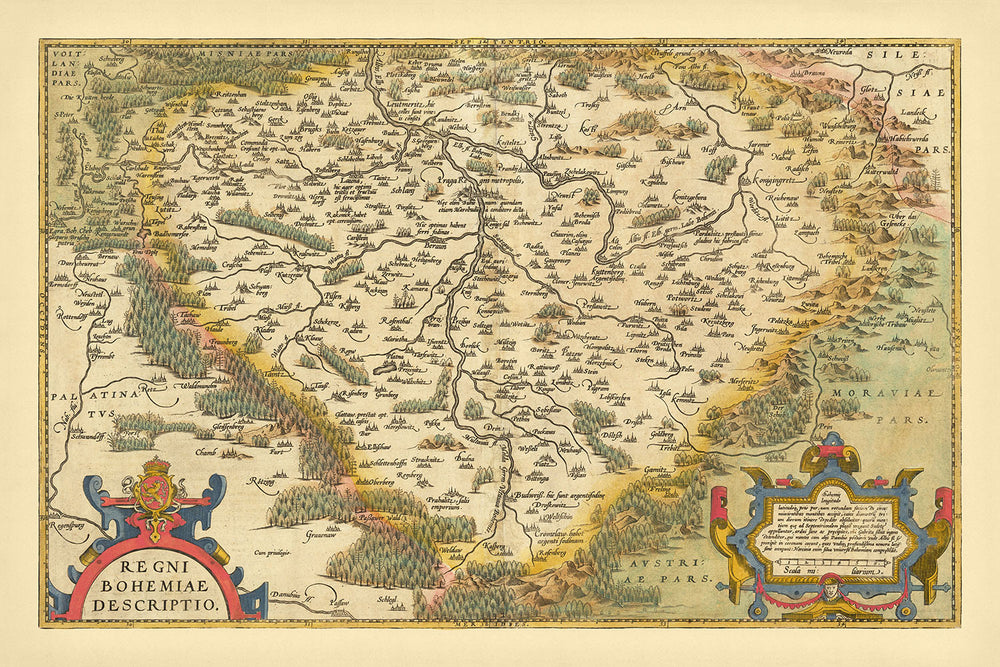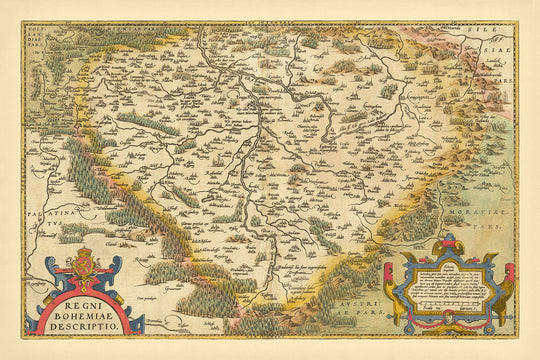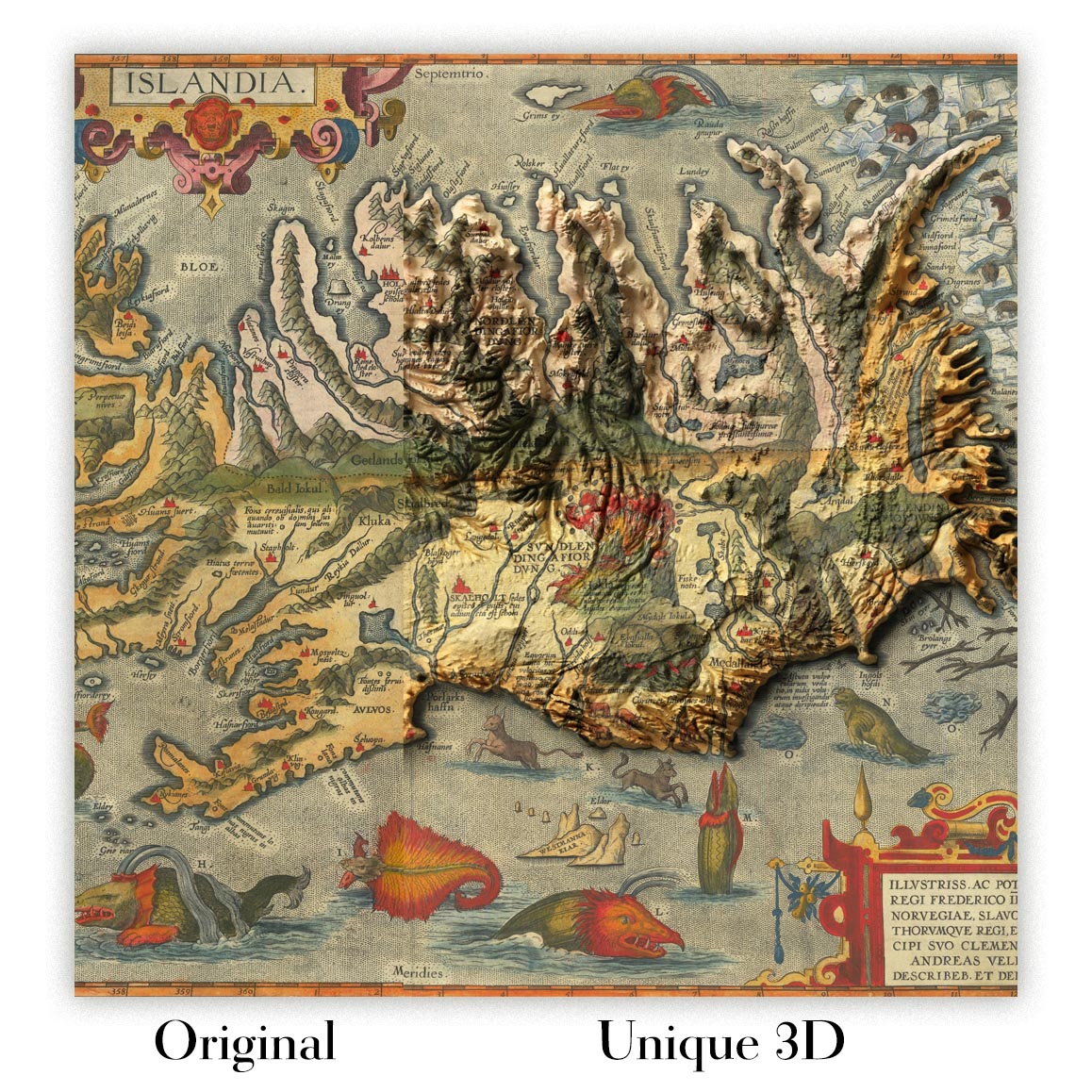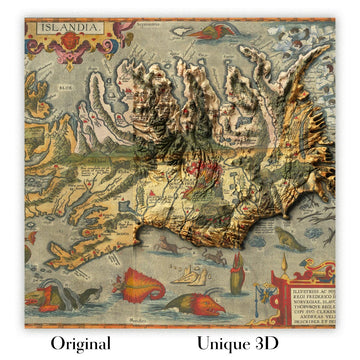- Handmade locally. No import duty or tax
- FREE worldwide delivery
- Love it or your money back (90 days)
- Questions? WhatsApp me any time
Own a piece of history
5,000+ 5 star reviews


The "Regni Bohemiae Descriptio," crafted by the illustrious Abraham Ortelius in 1579, is a masterful depiction of Bohemia, centered on the historically rich city of Prague. This map, part of Ortelius' seminal work "Theatrum Orbis Terrarum," the first modern atlas of the world, offers an intricate glimpse into the political and physical landscape of the region during the late Renaissance. Based on regional maps by Johann Criginger, it showcases a wealth of detail, from bustling towns and meandering rivers to dense woods and imposing mountain ranges, all meticulously illustrated to convey the essence of Bohemia.
Abraham Ortelius, a Flemish cartographer and geographer, revolutionized the field of cartography with his innovative approach to mapmaking. His work on the "Theatrum Orbis Terrarum" marked a significant leap forward, as it compiled detailed maps of various regions into a cohesive and accessible format. Ortelius' dedication to accuracy and artistic flair is evident in the "Regni Bohemiae Descriptio," where he combines geographical precision with decorative elements, such as ornate cartouches and a regal coat of arms, enhancing both the map's utility and its aesthetic appeal.
The map's depiction of Bohemia is rich with geographical and political details. It highlights the region's extensive network of rivers, including the prominent Vltava (Moldau) River, which flows through the heart of Prague. The map also delineates the borders of Bohemia, showing its neighboring regions such as Moravia and Austria. The lush forests and rugged mountain ranges are illustrated with great care, providing a vivid representation of the natural landscape that shaped the lives of the inhabitants during the 16th century.
Ortelius' map is not just a geographical document but also a historical artifact that offers insights into the region's settlements and their relative importance. Cities and towns such as Prague, Plzeň, and Ústí nad Labem are prominently featured, reflecting their significance in the socio-economic fabric of Bohemia. The map also includes smaller towns and villages, each meticulously placed, providing a comprehensive view of the region's human geography. This attention to detail underscores the map's value as a historical record, capturing the essence of Bohemia during a pivotal period in its history.
The "Regni Bohemiae Descriptio" is a testament to Ortelius' skill and vision as a cartographer. It serves as a window into the past, offering modern viewers a chance to explore the rich tapestry of Bohemia's geography and history. The map's combination of detailed cartography and artistic embellishment makes it a prized piece for collectors and historians alike, embodying the spirit of discovery and the quest for knowledge that defined the Renaissance era.
Cities and towns on this map
- Prague (Praha)
- Plzeň
- Ústí nad Labem
- Liberec
- Hradec Králové
- Pardubice
- České Budějovice
- Jihlava
- Karlovy Vary
- Teplice
- Mladá Boleslav
- Kolín
- Tábor
- Kutná Hora
- Písek
- Klatovy
- Cheb
- Domažlice
- Rakovník
- Beroun
- Litoměřice
- Most
- Chomutov
- Trutnov
- Jičín
- Náchod
- Rychnov nad Kněžnou
- Chrudim
- Svitavy
- Žďár nad Sázavou
- Třebíč
- Havlíčkův Brod
- Pelhřimov
- Strakonice
- Prachatice
- Jindřichův Hradec
- Znojmo
- Benešov
- Kladno
- Slaný
- Roudnice nad Labem
- Děčín
- Litvínov
- Jablonec nad Nisou
- Turnov
- Mnichovo Hradiště
- Nový Bydžov
- Jaroměř
- Dvůr Králové nad Labem
- Vysoké Mýto
- Polička
- Moravská Třebová
- Boskovice
- Velké Meziříčí
- Humpolec
- Tábor
- Písek
- Vodňany
- Vimperk
- Kaplice
- Třeboň
- Dačice
- Slavonice
- Mikulov
- Hustopeče
- Kyjov
- Bučovice
- Vyškov
- Blansko
- Tišnov
- Rosice
- Ivančice
- Moravský Krumlov
- Hodonín
- Břeclav
- Lanžhot
- Veselí nad Moravou
- Uherské Hradiště
- Uherský Brod
- Valašské Meziříčí
- Rožnov pod Radhoštěm
- Vsetín
- Kroměříž
- Holešov
- Bystřice pod Hostýnem
- Zlín
- Otrokovice
- Napajedla
- Vizovice
- Luhačovice
- Slavičín
- Brumov-Bylnice
- Valašské Klobouky
- Uherský Ostroh
- Strážnice
- Bzenec
- Klentnice
- Pavlov
- Lednice
- Valtice
- Pohořelice
Notable Features & Landmarks
- Inset maps: None visible
- Illustrations:
- Two decorative cartouches
- A coat of arms
- Landmarks: None specifically labeled
- Bodies of water:
- Several rivers are depicted, including the Vltava (Moldau) River.
- Borders:
- Political boundaries of Bohemia and neighboring regions
- Mountains:
- Various mountain ranges are illustrated, particularly along the borders.
- Other notable features:
- Extensive depiction of forests and woods
Historical and design context
- Name of the map: Regni Bohemiae Descriptio
- When the map was made: 1579
- Mapmaker or publisher: Abraham Ortelius
- Context about the mapmaker: Ortelius was a renowned Flemish cartographer and geographer, known for creating the first modern atlas. His work significantly advanced the field of cartography.
- Topics and themes shown on the map:
- Political boundaries and settlements
- Physical features such as rivers, woods, and mountains
- Context about themes: The map provides a comprehensive view of Bohemia's geography and political landscape during the late 16th century.
- Countries and regions shown on the map: Bohemia, parts of neighboring regions like Moravia and Austria.
- Context about the design or style of the map:
- The map features detailed illustrations and decorative elements typical of the late Renaissance cartography.
- It includes ornate cartouches and a coat of arms, enhancing its aesthetic appeal.
- Historical significance or context of the map:
- This map is significant for its detailed representation of Bohemia during the late 16th century.
- It is part of the first modern atlas, marking a pivotal moment in the history of cartography.
Please double check the images to make sure that a specific town or place is shown on this map. You can also get in touch and ask us to check the map for you.
This map looks great at every size, but I always recommend going for a larger size if you have space. That way you can easily make out all of the details.
This map looks amazing at sizes all the way up to 90in (230cm). If you are looking for a larger map, please get in touch.
The model in the listing images is holding the 24x36in (60x90cm) version of this map.
The fifth listing image shows an example of my map personalisation service.
If you’re looking for something slightly different, check out my collection of the best old maps to see if something else catches your eye.
Please contact me to check if a certain location, landmark or feature is shown on this map.
This would make a wonderful birthday, Christmas, Father's Day, work leaving, anniversary or housewarming gift for someone from the areas covered by this map.
This map is available as a giclée print on acid free archival matte paper, or you can buy it framed. The frame is a nice, simple black frame that suits most aesthetics. Please get in touch if you'd like a different frame colour or material. My frames are glazed with super-clear museum-grade acrylic (perspex/acrylite), which is significantly less reflective than glass, safer, and will always arrive in perfect condition.
This map is also available as a float framed canvas, sometimes known as a shadow gap framed canvas or canvas floater. The map is printed on artist's cotton canvas and then stretched over a handmade box frame. We then "float" the canvas inside a wooden frame, which is available in a range of colours (black, dark brown, oak, antique gold and white). This is a wonderful way to present a map without glazing in front. See some examples of float framed canvas maps and explore the differences between my different finishes.
For something truly unique, this map is also available in "Unique 3D", our trademarked process that dramatically transforms the map so that it has a wonderful sense of depth. We combine the original map with detailed topography and elevation data, so that mountains and the terrain really "pop". For more info and examples of 3D maps, check my Unique 3D page.
For most orders, delivery time is about 3 working days. Personalised and customised products take longer, as I have to do the personalisation and send it to you for approval, which usually takes 1 or 2 days.
Please note that very large framed orders usually take longer to make and deliver.
If you need your order to arrive by a certain date, please contact me before you order so that we can find the best way of making sure you get your order in time.
I print and frame maps and artwork in 23 countries around the world. This means your order will be made locally, which cuts down on delivery time and ensures that it won't be damaged during delivery. You'll never pay customs or import duty, and we'll put less CO2 into the air.
All of my maps and art prints are well packaged and sent in a rugged tube if unframed, or surrounded by foam if framed.
I try to send out all orders within 1 or 2 days of receiving your order, though some products (like face masks, mugs and tote bags) can take longer to make.
If you select Express Delivery at checkout your order we will prioritise your order and send it out by 1-day courier (Fedex, DHL, UPS, Parcelforce).
Next Day delivery is also available in some countries (US, UK, Singapore, UAE) but please try to order early in the day so that we can get it sent out on time.
My standard frame is a gallery style black ash hardwood frame. It is simple and quite modern looking. My standard frame is around 20mm (0.8in) wide.
I use super-clear acrylic (perspex/acrylite) for the frame glass. It's lighter and safer than glass - and it looks better, as the reflectivity is lower.
Six standard frame colours are available for free (black, dark brown, dark grey, oak, white and antique gold). Custom framing and mounting/matting is available if you're looking for something else.
Most maps, art and illustrations are also available as a framed canvas. We use matte (not shiny) cotton canvas, stretch it over a sustainably sourced box wood frame, and then 'float' the piece within a wood frame. The end result is quite beautiful, and there's no glazing to get in the way.
All frames are provided "ready to hang", with either a string or brackets on the back. Very large frames will have heavy duty hanging plates and/or a mounting baton. If you have any questions, please get in touch.
See some examples of my framed maps and framed canvas maps.
Alternatively, I can also supply old maps and artwork on canvas, foam board, cotton rag and other materials.
If you want to frame your map or artwork yourself, please read my size guide first.
My maps are extremely high quality reproductions of original maps.
I source original, rare maps from libraries, auction houses and private collections around the world, restore them at my London workshop, and then use specialist giclée inks and printers to create beautiful maps that look even better than the original.
My maps are printed on acid-free archival matte (not glossy) paper that feels very high quality and almost like card. In technical terms the paper weight/thickness is 10mil/200gsm. It's perfect for framing.
I print with Epson ultrachrome giclée UV fade resistant pigment inks - some of the best inks you can find.
I can also make maps on canvas, cotton rag and other exotic materials.
Learn more about The Unique Maps Co.
Map personalisation
If you're looking for the perfect anniversary or housewarming gift, I can personalise your map to make it truly unique. For example, I can add a short message, or highlight an important location, or add your family's coat of arms.
The options are almost infinite. Please see my map personalisation page for some wonderful examples of what's possible.
To order a personalised map, select "personalise your map" before adding it to your basket.
Get in touch if you're looking for more complex customisations and personalisations.
Map ageing
I have been asked hundreds of times over the years by customers if they could buy a map that looks even older.
Well, now you can, by selecting Aged before you add a map to your basket.
All the product photos you see on this page show the map in its Original form. This is what the map looks like today.
If you select Aged, I will age your map by hand, using a special and unique process developed through years of studying old maps, talking to researchers to understand the chemistry of aging paper, and of course... lots of practice!
If you're unsure, stick to the Original colour of the map. If you want something a bit darker and older looking, go for Aged.
If you are not happy with your order for any reason, contact me and I'll get it fixed ASAP, free of charge. Please see my returns and refund policy for more information.
I am very confident you will like your restored map or art print. I have been doing this since 1984. I'm a 5-star Etsy seller. I have sold tens of thousands of maps and art prints and have over 5,000 real 5-star reviews. My work has been featured in interior design magazines, on the BBC, and on the walls of dozens of 5-star hotels.
I use a unique process to restore maps and artwork that is massively time consuming and labour intensive. Hunting down the original maps and illustrations can take months. I use state of the art and eye-wateringly expensive technology to scan and restore them. As a result, I guarantee my maps and art prints are a cut above the rest. I stand by my products and will always make sure you're 100% happy with what you receive.
Almost all of my maps and art prints look amazing at large sizes (200cm, 6.5ft+) and I can frame and deliver them to you as well, via special oversized courier. Contact me to discuss your specific needs.
Or try searching for something!







